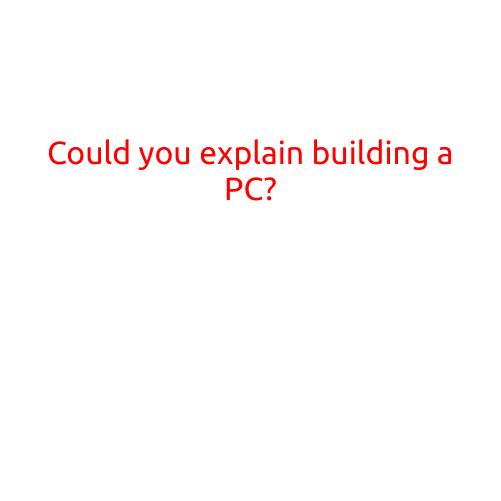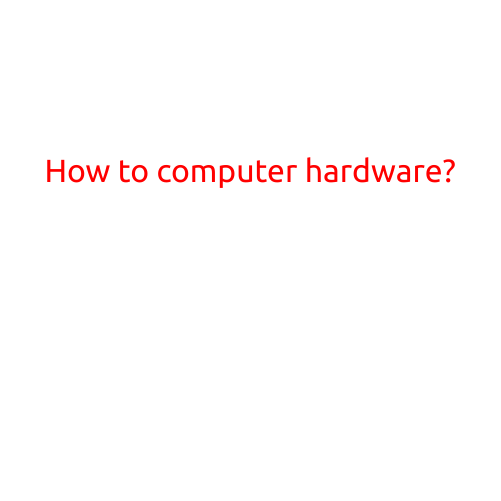
Could You Explain Building a PC?
Are you considering building your own personal computer? Perhaps you’re looking to upgrade your existing rig or create a custom gaming PC that meets your specific needs. Whatever the reason, building a PC can be a rewarding and cost-effective way to get exactly what you want in a machine. However, for those who are new to the world of PC building, the process can seem overwhelming.
In this article, we’ll take a step-by-step approach to explaining how to build a PC, from preparing the necessary components to installing the operating system and getting up and running. By the end of this guide, you’ll have a solid understanding of the process and be ready to start building your own custom PC.
Preparation is Key
Before you start building your PC, there are a few things you should do to prepare:
- Choose your components: Decide on the specific components you want to use in your build, including the CPU, motherboard, GPU, RAM, storage, and power supply. Make sure they are compatible with each other.
- Gather your tools: You’ll need a few basic tools to assemble your PC, such as a screwdriver, pliers, and a wrench.
- Clean your workspace: Make sure your workspace is clean and free of dust and debris to prevent any damage to your components during the build process.
Step 1: Unpacking and Preparation
Once you have your components and are ready to start building, follow these steps:
- Unpack your components: Carefully unpack each component from its packaging and lay them out on your workspace.
- Ground yourself: Static electricity can damage your components, so touch a grounded metal object or wear an anti-static wrist strap to discharge any static electricity from your body.
- Identify the CPU and socket: Locate the CPU (central processing unit) and its socket on the motherboard. Make sure they are compatible and correctly aligned.
Step 2: Assembling the CPU
To assemble the CPU, follow these steps:
- Remove the CPU cooler (if applicable): If your CPU comes with a cooler, remove it and set it aside.
- Apply thermal paste (if applicable): If your CPU requires thermal paste, apply a small amount to the top of the CPU.
- Insert the CPU into the socket: Carefully align the CPU with the socket and gently push it into place.
- Secure the CPU: Use the lever or knob on the socket to secure the CPU in place.
Step 3: Assembling the Motherboard
Once the CPU is installed, it’s time to assemble the motherboard:
- Install the motherboard standoffs: If your case requires standoffs, install them now to elevate the motherboard off the bottom of the case.
- Mount the motherboard: Place the motherboard in the case and secure it using the screws provided.
- Connect the power connectors: Locate the power connectors on the motherboard and connect them to the power supply.
- Connect the front panel headers: Connect the front panel headers, such as USB ports and audio jacks, to the motherboard.
Step 4: Assembling the GPU
To assemble the GPU, follow these steps:
- Remove the GPU from its packaging: Carefully remove the GPU from its packaging and handle it by the edges to avoid damaging the fragile components.
- Install the GPU into the PCIe slot: Gently push the GPU into the PCIe slot on the motherboard. Make sure it is securely seated.
- Connect the GPU power cables: Connect the power cables from the power supply to the GPU.
Step 5: Assembling the RAM
To assemble the RAM, follow these steps:
- Remove the RAM from its packaging: Carefully remove the RAM from its packaging and handle it by the edges to avoid damaging the fragile components.
- Install the RAM into the DIMM slots: Gently push the RAM into the DIMM slots on the motherboard. Make sure they are securely seated.
Step 6: Assembling the Storage and Power Supply
To assemble the storage and power supply, follow these steps:
- Install the storage drives: Install the storage drives, such as hard drives or solid-state drives, into the case.
- Connect the storage drives to the motherboard: Connect the storage drives to the motherboard using SATA or IDE cables.
- Install the power supply: Install the power supply into the case and connect the power cables to the components.
Step 7: Booting Up and Installation
Once all the components are assembled, it’s time to boot up your PC and install the operating system:
- Connect the power cables: Connect the power cables to the power supply and the components.
- Boot up the PC: Press the power button on the power supply to boot up the PC.
- Install the operating system: Install the operating system, such as Windows or Linux, onto the storage drives.
Conclusion
Building a PC can seem like a daunting task, but by following these step-by-step instructions, you can create a custom PC that meets your specific needs. Remember to prepare your components, ground yourself, and take your time when assembling each component. With patience and practice, you’ll be building PCs like a pro in no time. Happy building!





